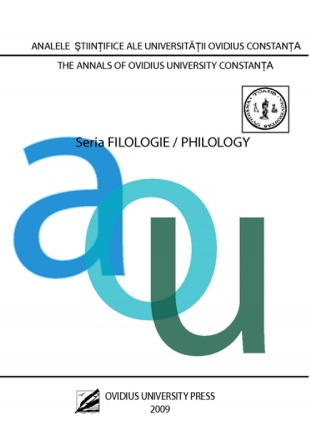The Order beyond the Hazards: Pronominal Reference and the Significance of Space-Time Markers in The Hazards by Jane O. Wayne
The Order beyond the Hazards: Pronominal Reference and the Significance of Space-Time Markers in The Hazards by Jane O. Wayne
Author(s): Claudia PisoschiSubject(s): Language and Literature Studies, Applied Linguistics
Published by: Ovidius University Press
Keywords: deictic; space marker; psychological time; pronominal reference; subjective.
Summary/Abstract: The poem “The Hazards” by Jane O. Wayne is an original token in its use of the linguistic means of marking space and time at the discourse level, providing thus a unique opportunity for a pragma-stylistic analysis. Nothing is, in fact, hazardous in the structure of the poem,its naturalness matching its profoundness which the instruments of linguistic stylistics aid in revealing. The initial intertext represented by the motto, a quote from Henri Bergson, guides the reader to the significance of psychological time, as this is implicitly one of the themes of the poem: the circularity of the poem’s structure is paralleled by that of its content and lies exactly in the process of internalizing Bergson’s idea, i.e. the need to acknowledge that time is patience. In between the motto and the ending, the poem evolves as an artistic illustration of localism, space markers functioning as visually relevant time markers and, moreover, as complex elevated symbols: the waves, the dunes, the horse, the locks, the pigeon, the pear.Abrupt and intense, the text involves the reader in the kinematic scenario, the setting becoming a key element, since it is the embodiment of the poetic voice facets. The play upon subjective perspectives is reflected by the consciously ambiguous play upon pronominal reference, between the deictic and non-deictic interpretations. Thus, there results a perfectly mastered match between pronominal reference and the setting triggered by it, in their specific vs. generic occurrences.The past is a part of the present, even equivalent to it if we consider the space-time continuum, but subjectively, it doesn’t become so unless it is understood and accepted. Both the philosophy and the structure of the poem corroborate this message; the poetess opens multiple possible directions of interpretation, all arisen from and spiritually located in our background, but equally exploiting old and new symbols.
Journal: Analele Universităţii Ovidius din Constanţa. Seria Filologie
- Issue Year: XXX/2019
- Issue No: 2
- Page Range: 281-294
- Page Count: 14
- Language: English

